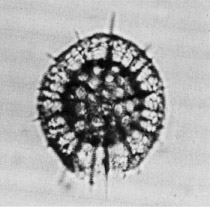 Sphaeropyle
langii Dreyer
Sphaeropyle
langii Dreyer Sphaeropyle
langii Dreyer
Sphaeropyle
langii DreyerSphaeropyle langii Dreyer, 1889, p.13, pl.4, fig.54; Kling, 1973, p.634, pl.1, figs.5-10, pl.13, figs.6-8 (with synonymy); Foreman, 1975, p.618, pl.9, figs.30-31 (with synonymy)
There are four concentric porous spheres of which the diameters are in the relative proportion of 1:3:9:14. All four spheres are perfectly round if we disregard the pylome and some undulations of the outermost shell. The spheres are thin and are connected by relatively few radial beams that continue beyond the outer sphere as thorns. These radial thorns are all approximately the same size and length and are double the length of the diameter of the innermost sphere. The innermost sphere is only recognizable as a shadow and therefore the structure cannot be recognized. The second and fourth spheres are similar in their structure, the pores are subcircular and of unequal size and somewhat smaller than the intervening bars. In contrast the pores of the third sphere are about three times wider than those of the second and fourth spheres and three to four times wider than the intervening bars. Moreover, they are subcircular and of unequal size. The spheres have a smooth surface. The pylome is large and clearly visible and its rim is covered with thorns or teeth of unequal size (translated from Dreyer, 1889).
Based on 50 specimens. Diameter of outer shell 110-210 µm, second shell 70-114 µm, third shell 25-45 µm, innermost shell 12-15 µm. Thickness of outer shell 3-15 µm (Foreman, 1975).
See under Sphaeropyle robusta.
The morphotypic first appearance of this species defines the base (approximately equivalent to the Miocene/Pliocene boundary) of the Sphaeropyle langii Zone in the North Pacific (Foreman, 1975). It is extant. Casey and Reynolds (1980) believe it to be cosmopolitan, but is more common in high and middle latitudes.
The evolutionary transition of this species from Sphaeropyle robusta occurs near the Pliocene-Pleistocene boundary. It is extant.
Examination of North Pacific material has led us to believe that the distinctions between S. langii and S. robusta are not at all clear and hence that S. langii is not a suitable zonal marker.